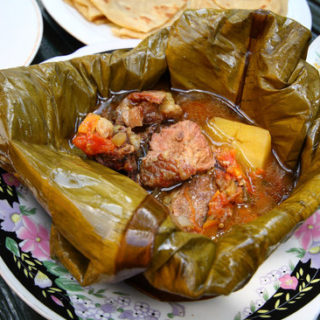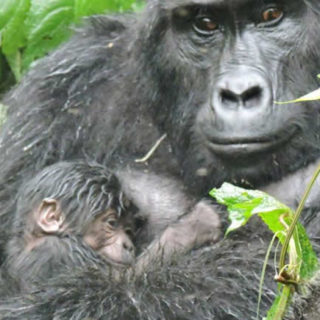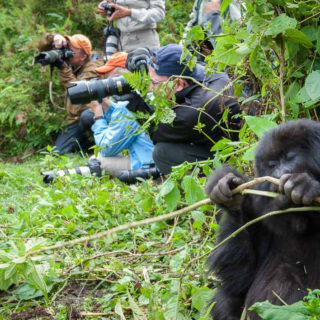Ugandan Cuisine – Local Food and Beverages
Ugandan Food/feast (Delicacies)
Uganda is blessed with various cultures that have different delicacies that makes Uganda a favorite destination for tourists who would like a great taste of our savory meals given the different cuisines found in the different parts of Uganda and we are to categorize the different local cuisines according to the regions which are mainly; northern, eastern, western and central Uganda:
In the central there are various cuisines given the different cultures found there and these include, starchy foods, sauces, beverages, fruits and desserts. The main dishes include;
Matooke (bananas)
The matooke are majorly grown in the central districts of Uganda and some western region like the Ankole region. It is the main staple food among the Baganda tribe who are having pride in making the best matooke dishes. The matooke are harvested freshly from the garden, peeled, and cooked in banana leaves and tied in the heap and steamed.
They are served in a mushy heap and eaten with different stews like chicken, meat, fish, groundnuts and beans among others. They can also be cooked in a form of katogo which can be of G nuts, beans, offal and meat with traditional vegetables that is usually served as a traditional breakfast and this time round the matooke are not smashed as before.
They are just peeled, cooked with the stew as there is no need of preparing another stew. Katogo is not only prepared using matooke but also other food types like cassava. There other types of matooke like the plantain matooke which are known locally as Gonja. It is green in color if raw and it is harvested when its ripe which is brownish.
It can be cooked or smoked on top of the matooke meal and it can be roasted. it has a brownish color and a sweet taste if ready. This can also be used to make gonja crisps which are widely sold in the supermarkets as fast foods.
Other types of matooke include the sweet bananas which are differentiated into two locally “ndiizi” and “bogoya” which are served as a sweetener or a desert these are severed when ripe and have a sweet taste and it’s from this taste that ndiizi derived its name sweet banana “ndiizi” to differentiate it from other sweet bananas and also they are called sweet because of their taste.
The products that can be made from these types of matooke include; pancakes which are made from mixing the flour and the mashed sweet bananas, rolled and cut into different shapes as desired, fried and served as a snack for breakfast and they can also make crisps from them.
Kivuvu (Apple Banana ) is another form of matooke that is steamed on top of the main meal that is cooked when it is unpeeled and it can be eaten for breakfast or desert.
Given that matooke is a food plant there are other products that can be made out of matooke which include banana flour that are sold in the supermarket.
Luwombo
The Luwombo is traditionally prepared among the Buganda culture and it is made of various sauces which includes, chicken, Gnuts, beef, smoked fish and vegetables like carrots, green peppers, potatoes etc. wrapped in banana leaves and steamed with the right amount of water, oil and spices.
It is a special dish that was prepared by Kabaka Mwanga’s personal chef. Today the dish is prepared mostly on special occasions like introduction ceremonies given to the “Bako” (in-laws), special days like Christmas and also they are given to special visitors and if u get to visit someone and you are prepared a Luwombo, it shows that you are taken as a special guest however, today one can have a Luwombo in our different eateries mostly those that prepare local food and also from different community incentives
Other types of delicacies in the central include sweet potatoes which are prepared as food at the same time as the breakfast snack .the sweet potatoes locally known as lumonde by the Baganda and “embooli” by the Basoga can be used to make a traditional meal locally known as “omugoyo” that is made by mashing the boiled sweet potatoes mixed with the red kidney beans known as “nambaale” then mingled together giving out a yummy starch meal. It is then cooked on firewood on the local coking place known as “ekyoto” (local stove), then it is baked in a process called “okuboobeza”.
The major reason why it is cooked over firewood is because the smoke from firewood gives it a great scent and adds a great taste to it .This can be accompanied with a glass of juice or water. it was common in the iteso communities but the Baganda also adopted it and it was commonly prepared by the aging women and the myth about it is that the lovers were not supposed to serve each other omugoyo as it may result in a failed relationship.
The yams they are locally called “mayuni” and are always grown in areas with a lot of rainfall thus the central and eastern regions being ideals place for them to be grown they are in different types baluggu, Bwaise (Arrow yams) and when preparing these yams the arrow roots are steamed with or without peelings, Obukopa (small yams), Ndungu they can be prepared with peelings. The yams can be prepared as a meal when steamed and served as breakfast or dessert with tea as they can also be used to make the yam crisps.
ESENENE (GRASSHOPPERS)
These are periodic insects that always appear in rainy seasons more so in November and December. Masaka is well known for this type of insects as they are sold in plenty along the way or on the road sides. During the season, people wake up early morning to gather them, as some set up lights and big drum tanks pus iron sheets to collect them as the lights attract them and as they fly around them, they easily slide on the iron sheets that reflect the light and slide into the drum trunks where the iron sheets are placed thus collecting as plenty as possible. They are packed into big sacks and taken for sell as they are an income to some people during the season.
They are sold fried or raw but before frying them one has to get charcoal ash to assist in pulling off the legs and wings to easy the process of preparing them for frying. You can fry them without oil as they contain their own fats and when they are golden brown you can add in other spices like onions and tomatoes, garlic and green pepper plus salt to get a yummy taste.
The collection of the nsenene in rural areas where there is no electricity is different where they search for them in bush thickets and plantations. People have now started preserving them and can sell them in other seasons other than the known rainy seasons. When one gets a chance to find them on his or her visit should try these finger linking insects.
White ants (enswa)
Apart from the nsenene, ants too are enjoyed in Uganda by different groups like the tribes in the west Nile among the Madi, Kawa and Anugu, Japadhola and Acholi and also in the central among the Baganda and these various groups prepare the ants in different ways as the west Nile roast, boil and pound them and mix them to form a paste mixed with groundnut or simsim paste as they are preserved for consumption after the season as in the central they are fried and eaten as a snack.
The white ants originate from anti hills that are made by the ants which are found mostly in the remote areas of the country. The Buganda categorized the white ants into three groups “enswa ensejjere” and these are the universal type picked from the anthills when the termites open up holes on the anthills and people cover the anthill with sacks and grass and the ants lose their way and slide into a hole where the container has been prepared to tap them.
The second type is the “mbobya” which appear during or after the rainy season and they are spotted around any source of light or floating on water. The last category is the ennaka and they are the smallest of them all and are usually eaten raw as the rest are prepared as a dish or as a snack.
AMALEWA
The malewa are commonly known as a traditional food for the Bagishu in the eastern Uganda. They are got from the bamboo shoots grown around mountain Elgon.
The bamboo shoots are hung up to dry above the fireplace for about three days, soak it in water for half an hour if soft, trim off the hard parts and then cut the soft part into small pieces wash them again in water thoroughly, boil and add it to the soaked dissolved Magadi (rock salt) then add ground nuts sauce after thirty minutes on heat and then boil again for about thirty five minutes. This can be severed with plantain, sweet potatoes and cassava.
AKALO
This is mostly prepared in the western, eastern and northern regions of Uganda where it is made from millet flour that is mixed with cassava flour and mingled using hot water and it can be eaten with very many sauces like beans, mushrooms and beef to mention but a few.
ESHABWE
Eshabwe is a local delicacy prepared commonly by the Banyankole and Bahima. It is basically a thick white sauce that is made from mature unboiled clean ghee and salt( both rock and table) and it is usually served on important occasions like okuhijila(introduction ceremony). It can be prepared manually or using a blender to ease the process but hygiene must be strictly observed.
Malakwang
Malakwang is a tinge vegetable and the sauce is traditionally prepared from northern Uganda by the Acholi though intermarriages have made the sauce known across the country. Aunties taught their girls how to prepare it in preparation for marriage and advised them to always prepare it during the time of challenges in order to remind them of their good moments thus interpreting the sour and the sweet taste of the Malakwang.
And it was not served during traditional marriage as it was believed that the marriage could not last long though it is served on other occasions like graduations and birthdays AND served to the in-laws when they visit and also when parents visit their daughters’ home as a special dish. It is good for breastfeeding mothers and its soup is squeezed from the leaves is used as a temporary first aid on wounds.
Kawunga (posho)
It is also called Ugali in the Swahili language and can be made from maize flour or cassava flour. it takes little time to prepare as one takes little time to mingle it. one may decide to wrap it in banana leaves to give it a fine aroma. The food is accompanied with various sauces and soups such as fish dishes, meat dishes, beans, groundnuts mushroom soup, peas sauce, and offals etc.
Rolex
It is a fast snack that originated from eastern Uganda in Busoga and it became popular in Makerere University since it is a fast snack that can be eaten at any time; breakfast, lunch and dinner that is available all around in Uganda at the roadside stalls. It is an omelet combined with cabbage, onions, tomatoes and it is rolled in a chapati thus gaining its name Rolex the way it is made.
It is relatively cheap based on the number of eggs to be used. The Rolex delicacy spread out very fast in Uganda and it was named among the top African fast foods by CNN thus opening it up to other countries like Rwanda in Kigali and Kenya. There’s also a Rolex festival that is celebrated annually.
Kikomado
This is a mixture of sliced chapatis and bean sauce or meat that are prepared at the roadside stalls. it is a fast food that is enjoyed by students or it can be a take away food that is cheaply accessible.
Ugandan eggroll
This is made from mashed rounded Irish potatoes with a boiled egg in the center, fried to a golden brown and served as a snack.
Adding on Uganda’s delicacies are the different beverages that are so unique and tasty if tasted. The beverages are both traditionally made and industrial made and they include;
Bushera
This is made from millet flour or from sorghum flour that is typically made and consumed in western Uganda the Banyankole and the Bakinga and it is served in Enkyeeka (a small gourd). it is very nutritious because of its natural form as there are no additives added to it. Bushera is used also to prepare alcoholic drinks in western Uganda like in the Kigezi highlands which include, Ekanga, Omuramba and Enturire.
KWETE
This is a drink made from fermented sorghum brewed using yeast and it is mostly consumed in Northern Uganda among the Lugbara.
Tonto or mwenge bigere (banana beer)
This is made from ripe bananas(kisubi or kayinja) that are covered in a pit for three days with banana leaves and then peeled and mixed with grass in a canoe, squeezed to get juice which is poured into containers, mixed with sorghum and diluted with water then left to ferment for about 24 hours then beer is got.
Banana wine
This is prepared from ripe bananas, boiling hot water, yeast and citric acid which are added then left to cool for 2 months.
BEERS, WINE AND SPIRITS
These are industrial locally made products made in Uganda from our own industries like Uganda breweries that make in different beers and spirits and the examples include Nile special, club pilsner and bell lager that are the most enjoyed beers more so in the evenings with friends.
We have our own spirit Uganda waragi which is also a special deal to spirit takers more so those eating pork. Alcohol is taken in Uganda on special restrictions like don’t drink and drive, not taken by children below the age of 18 and abuse of alcohol is harmful to your health and some of these are indicated on the bottles.
SODAS
We have sodas from international brands like coca cola products and Pepsi products though other companies have come up to make sodas like riham sodas that are refreshing.
Water
There are many companies that process mineral water that is safe for drinking like Rwenzori Company, Riham Company.
Other drinks include,
Tea (chai)
This can be black tea or milk that is made of water or milk mixed with our own grown tea leaves like garden tea at times spiced with ginger for a better evening tea or breakfast with katogo or bread and other snacks
Porridge
This is made from either millet, sorghum and maize flour, one can also add in milk to improve its taste and can be taken as breakfast with escorts like pancakes, samosas.
COFFEE
Uganda is known for its two types of coffee; Robusta and Arabica coffee that is highly grown in the east, west, southeast and central parts of Uganda. Arabica coffee is majorly grown in highlands on the slopes of mountain Elgon and Rwenzori while Robusta coffee is grown in the lowlands.
The coffee berries are harvested once ripe, processed, dried and roasted to varying degrees depending on the desired flavor and then are grounded and brewed with near boiling water to produce a beverage known as coffee that is darkly colored ,bitter and slightly acidic. After processing, it is packaged and sold to various shops for those who can’t make their own coffee.
FRUITS AND VEGETABLES
Uganda being a tropical country, it possess mainly tropical fruits thus describing it as “The Tropical Basket of Africa because of its diversity fruits. The unfamiliar jackfruit (fenne) that is little known to other countries but gives a magnificent taste, it is one of the fruits that give Uganda its unique name. it is a big fruit that grows on trees mostly around people’s homes, though it is not usually found in restaurants, some people may not like it because of its sap when cut but once tasted, it is very mouthwatering.
There are other fruits found in Uganda such as amatugulu, ekitafeli(soursop), guaves(amapela), amatuguda, passion fruits (obutunda), avocados, apples, citrus fruits, bananas, pineapples, mangoes watermelon, okra, vanilla, black berries (enkenene), empafu, jjambula, gooseberry (entuntunu), enkomamawanga (Pomegranate Fruit), sugarcanes (ekikajo) and cocoa (koko).
Uganda is also blessed with various notorious vegetables that are served on the main meals such as nakati (Ethiopian eggplant), spinacsh, bugga, cabbage, broccoli, dodo, jjombyo, Gombe, obuyindiyindi, ettimpa, ebiguju, essunsa, ebisobooza, kantunkuma, entula, ebigaga among others.
Uganda being a food hub not only does it consist of traditional foods but also modern cuisines around the world such as Arab and Asian cuisines such as Indian dishes and Chinese dishes, Italian cuisines , English food and not forgetting the vegan dishes that are available for vegetarians.
It is one of the reasons why Winston Churchill wrote in his book my African journey he described Uganda as one beautiful garden where the staple food of the people grows almost without labor comparing it to the paradise on earth and calling it the pearl of Africa. If one is interested in a foodie adventure, he should include Uganda on his must visit destinations.





